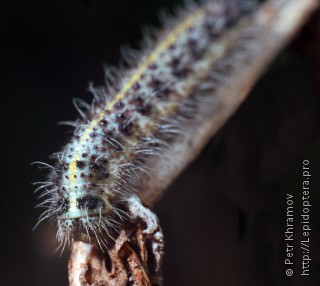Plants call for help butterfly enemies to save themselves from the forthcoming caterpillars
Community and Forum → Blog → Plants call for help butterfly enemies to save themselves from the forthcoming caterpillars
Lev Bely, 14.09.2012 10:11

According to a new research, plants can “call for help” to spare themselves from the butterfly offspring as when the latter are just about to lay eggs.
It's found out that plants start evolving scents and other volatile chemicals as a so-called SOS signal for their neighbours to help them to dispose of pest. In this research the pest is a butterfly that is going to lay eggs on a plant, which tries to prevent it not to suffer further from voracious caterpillars.
The study* published in the open access peer-reviewed scientific journal PloS ONE, looked at the activity of parasitic wasps (Trichogramma brassicae and Cotesia glomerata), a fertilized Large White butterfly (Pieris brassicae), a fertilized Cabbage moth (Mamestra brassicae), and a black mustard plant (Brassica nigra) after it had evolved those specific chemicals. Insects were observed at the moment of the first butterfly “attack” on the plant that was the egg-laying.
Lead researcher Nina Fatouros of the Laboratory of Entomology of Wageningen University and the Netherlands Institute of Ecology, discovered that the egg-laying provoked structural changes in the black mustard plant and made it evolve a special chemical that attracted different parasitic wasps. They in turn attacked butterfly eggs or its caterpillars. Interesting that the chemical also repelled other fertilized butterflies that could either lay eggs on the plant.
The egg-laying of a cabbage moth, for which the black mustard was not the main host plant but just one among others, as against didn't provoke the plant to “call for help” — the chemicals it evolved neither attracted “defenders”, nor repelled pests, or in this case, butterflies.
Another study made at the University of Western Australia revealed that plants could “respond” to sounds and “talk” to each other using some special “clicks”. Researchers hung up in water young roots of corn seedlings and provided a continuous 220Hz noise that was a frequency equivalent to the plant “clicking”. The roots turned out to grow towards the source of the sound.
“Everyone knows that plants react to light, and scientists also know that plants use volatile chemicals to communicate with each other, for instance, when danger — such as a herbivore — approaches,” Dr. Monica Gagliano said in a university news release.
The later research revealed that plants of the cabbage family emitted methyl jasmonate gas when their external parts were cut or pierced, to warn neighbouring plants of danger, could it be caterpillars or pruning shears. Scientists found out that the plant neighbours, having got such SOS signal, emitted toxic chemicals out on the leaves to deter caterpillars. Or pruners.
*The study in full is available on the PloS ONE website: http://www.plosone.org/article/info%3Adoi%2F10.1371%2Fjournal.pone.0043607.
MedicalDaily.com, http://www.medicaldaily.com
Photo: P. brassicae caterpillar
http://www.bbc.co.uk/news/science-environment-16916474
All the rest posts on: Australia, Pests, science, USA
Comments
New comment
Note: you should have a Insecta.pro account to upload new topics and comments. Please, create an account or log in to add comments.
* Our website is multilingual. Some comments have been translated from other languages.
Random species of the website catalog
News
- 10.12.2024: Новое поле в «Поиске энтомологов»
- 05.12.2024: Insecta.pro maps: filter by taxon
- 30.11.2024: Починена ссылка и страница «Мои подписки»
New photos (25.12.2024)
Fresh from the community
- 22:45, P. Khramov: Attagenus trifasciatus / Ivan Prist...
- 22:44, P. Khramov: Attagenus trifasciatus / Ivan Prist...
- 22:44, P. Khramov: Attagenus trifasciatus / Ivan Prist...
Popular insects
Recommended blog topics
- Meanwhile, at the "Reptilium"
- 20th International Insect Fair in Moscow (Russia, October 2023)
- Butterflies and music: Chilled Monkey Brains, Butterflies


























